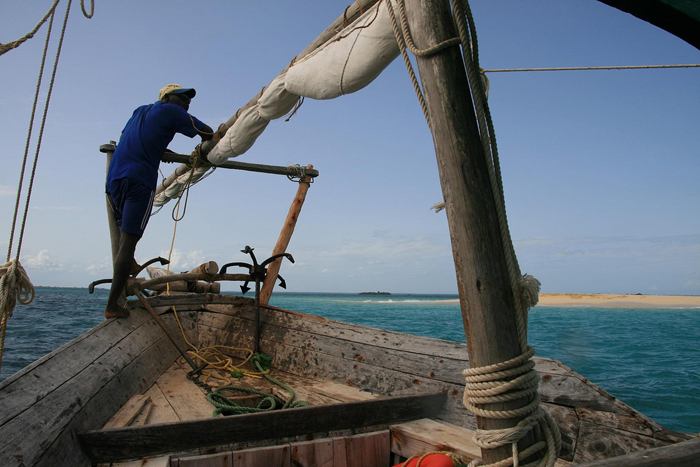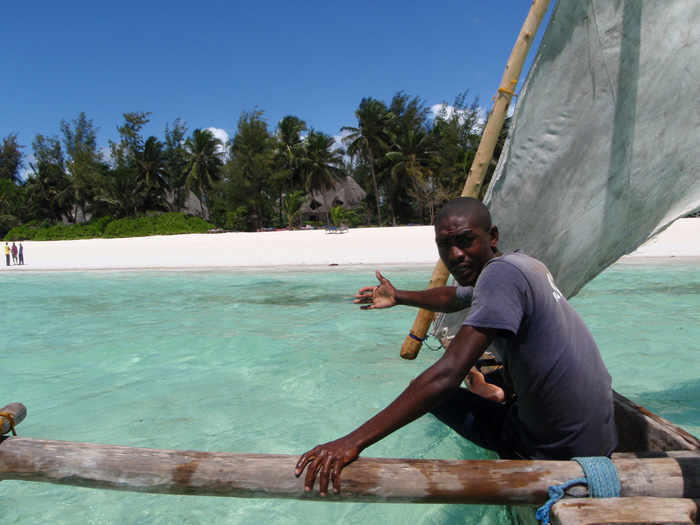Written by: Andrew Hofmeyr
Zanzibar, the jewel of the East African coastline, has it
all. With beautiful beaches, a fascinating history and cultural
influences that stretch from Europe to Asia and back through time to the
medieval Indian Ocean world, Zanzibar has an old-world charm that is
unique in Africa. But how did this cultural melting pot come into being?
Many influences from across the Indian Ocean are woven together here,
but to really understand the movement of people, languages and cultures
through this enchanting entrepôt you need look no further than the
dhow.
Traditional dhows
Very simply, the Swahili word ‘dhow’ is a generic term for the
pre-European ships of the Indian Ocean. Traditionally these dhows were
sewn together using coconut coir (fibre) – a medieval practice born from
the belief that magnets under the sea would suck any nails out of a
vessel, thus condemning the crew to certain death beneath the waves. The
dhows are typically rigged with a lateen sail, which is the classic
triangular-shaped sail attached to a cross beam that is raised and
lowered according to the winds. These boats range in size from small
fishermen’s boats to vessels over a hundred feet long!
The Baggala for example, is an ocean-going dhow with a curved prow
(the front) and an ornately carved stern (back) and usually has two
lateen sails. The Boom vessel on the other hand is curved at both ends
with a single large sail in the middle and was preferred by sailors from
the Persian Gulf. It is believed that these boats have moved around the
Indian Ocean for thousands of years carrying sailors from the Arabian
Peninsula, along the East African coast, to India and even, some
believe, as far as China.
Although there were many deep-water ships, the dhows were
predominantly used for coastal trade. Moving up and down the East
African coast, the dhows stopped at ports along the way, trading goods
and ferrying passengers. Before the onset of steam and later petrol,
these wind-powered ships were the cornerstones of a pulsating and
cosmopolitan ocean trade. The constant movement of tradable goods and
diverse people also meant the constant trade in ideas, technologies and
religion.
The ancient dhow trade is recorded in a small book called The Periplus of the Erytraen Sea.
Written in the first century by an unknown Greek author, the Periplus
is a guide to the ports, people and trade goods of Arabia, India and the
East African coast. The existence of this little book suggests a trade
route that has continued for thousands of years, as empires rose and
fell around it. A hint to its sustained importance over centuries lies
in the function of the seasonal monsoon.
Ecology and the monsoon winds
The Indian Ocean dhows sailed according to the monsoon trade winds
that enabled the movement of goods between rich, but completely
different ecological zones. The lush tropical zones of East Africa and
Madagascar were an important source of timber, gold and ivory, while the
nutrient rich waters surrounding the desert zones of North Africa and
the Arabian Peninsula were abundant in pearls, fish and dates.
In January, the north-east monsoon carried dhows, laden with dried
fish and pearls south from Arabia. In July, after nearly six months, the
cycle reversed and the south-west monsoon would blow the dhows, having
collected ivory, timber and gold back to Arabia. The combination of the
seasonal monsoons, extended layovers and the need to trade between the
different ecological zones created the ideal conditions for the
development of a complex and cosmopolitan society.
Zanzibar and the Indian Ocean
Zanzibar is particularly unique as it was not only the last port of
call for the Arabian dhows before sailing the treacherous waters of the
Mozambique channel, but it was also the destination of larger, open
ocean ships sailing from the Malabar coast of India. Seafaring culture
that saw sailors staying for extended periods of time (up to six months
waiting for the monsoon winds to change) meant that Zanzibar developed
as a cultural hub. Sailors from all around the Indian Ocean gathered
together, mixing religion, language and culture and it was not uncommon
for sailors to take wives and start families, thus deepening the bonds
between otherwise distant locations.
These ancient ties were further strengthened by the unification of
Islam under the Abbasid caliphate in the 9th century. This era of
peaceful trade and the spread of Islam is noted by some historians as
the “Era of Sindbad” – a nod to the importance of maritime trade and
commerce in history. This era of legendary figure – Sinbad the Sailor –
lasted until the appearance of the Portuguese in the late fifteenth
century, heralding a shift in the culture of the Indian Ocean.
Old Stone Town
Zanzibar, as the cultural nexus of this Indian Ocean trade, holds the
evidence of this diverse and exciting history in Stone Town. It is the
only functioning historical town in East Africa and its remarkably
well-preserved architecture (mostly from the 19th century), bears the
mark of Swahili, Arabian, Persian, Indian and even European influences.
In 2000 Stone Town was listed as a UNESCO World Heritage Site, as a direct result of its diverse historical and cultural influences.
Old Stone Town is the perfect place to soak up the old-world charm of
Zanzibar, with its winding alleys, bustling bazaars, grand merchant
houses and mosques calling to be explored.
Experience all that Zanzibar has to offer with African Budget Safaris.







No comments:
Post a Comment